Abstract
1. Following our earlier observations that the tachykinin NK1 receptor antagonist CP-99,994 is an effective anti-emetic in ferrets, we have examined the anti-emetic effects of a more potent and novel NK1 receptor antagonist, GR203040, against various emetic stimuli in the ferret, dog and house musk shrew (Suncus murinus). 2. In ferrets, GR203040 (0.1 mg kg-1 s.c. or i.v.) is effective against emesis induced by radiation, cisplatin, cyclophosphamide, copper sulphate, ipecacuanha or morphine. 3. In animals in which emesis had been established with cisplatin, GR203040 (1 mg kg-1 s.c.) was fully effective as an interventional treatment. No further emesis was seen in animals treated with GR203040 whilst saline-treated animals continued to vomit. 4. GR203040 (0.1 mg kg-1 s.c.) retains anti-emetic efficacy in the ferret, even when given as a 6 h pretreatment, indicating that this compound has a long duration of action. The compound is also effective orally at the same dose, when given as a 90 min pretreatment. 5. GR203040 (0.1 mg kg-1 i.v.) is fully effective against ipecacuanha-induced emesis in the dog. 6. GR203040 is effective against motion- and cisplatin-induced emesis in Suncus murinus. These effects were seen at doses an order of magnitude greater than those shown to be effective against cisplatin in the ferret. 7. In conclusion, GR203040 is a novel anti-emetic agent, and the broad spectrum of anti-emetic activity, together with activity observed in three species, suggests that this compound is worthy of clinical investigation.
Full text
PDF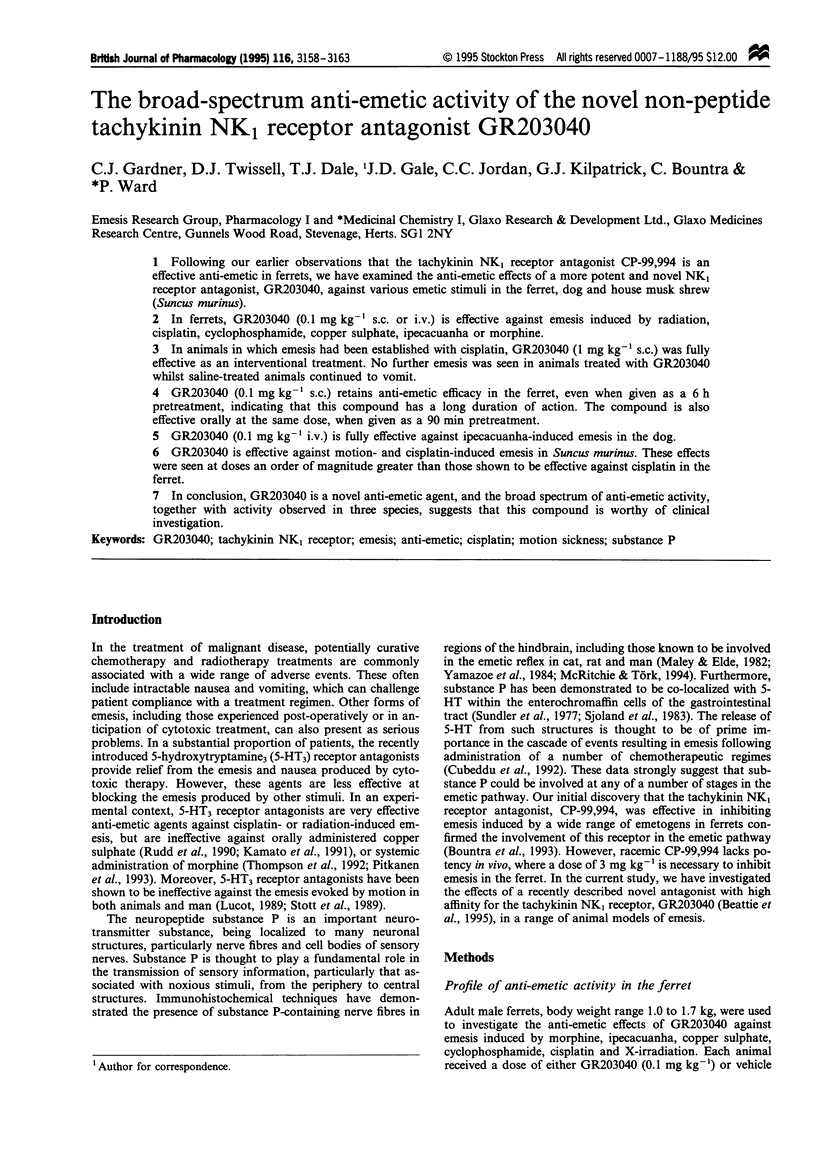
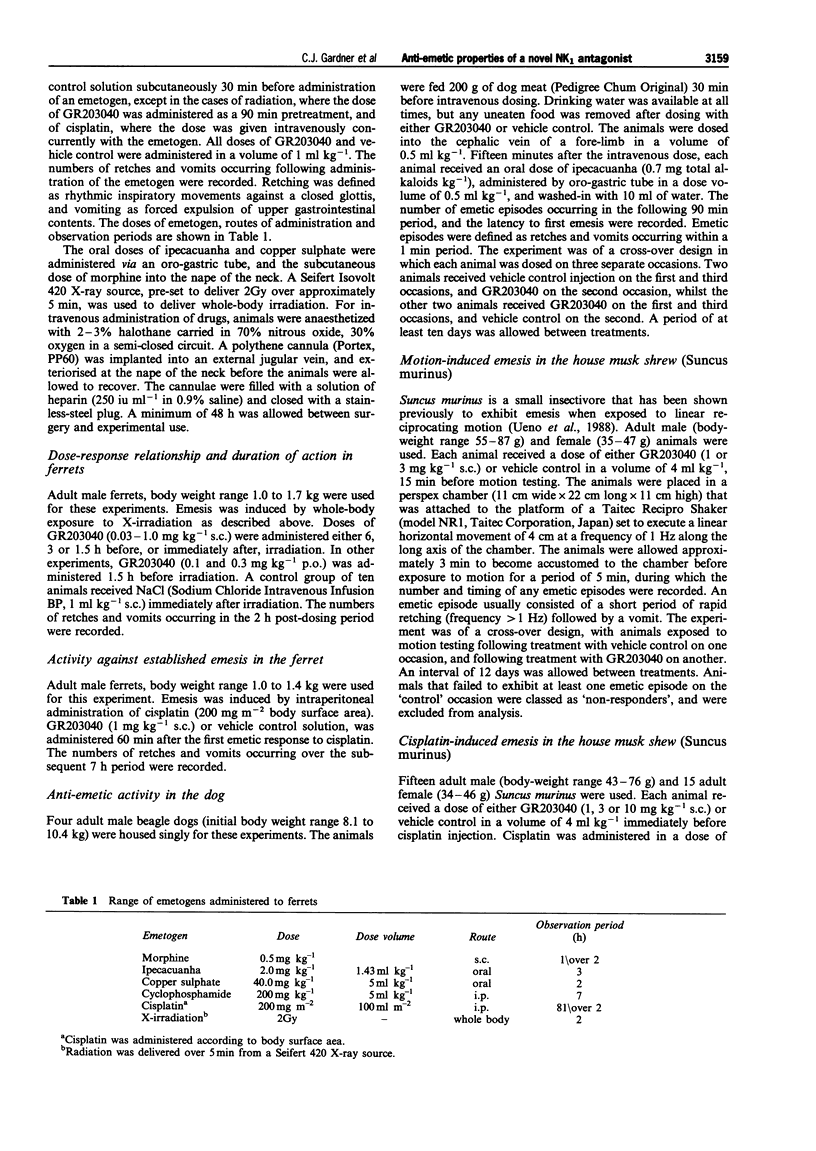
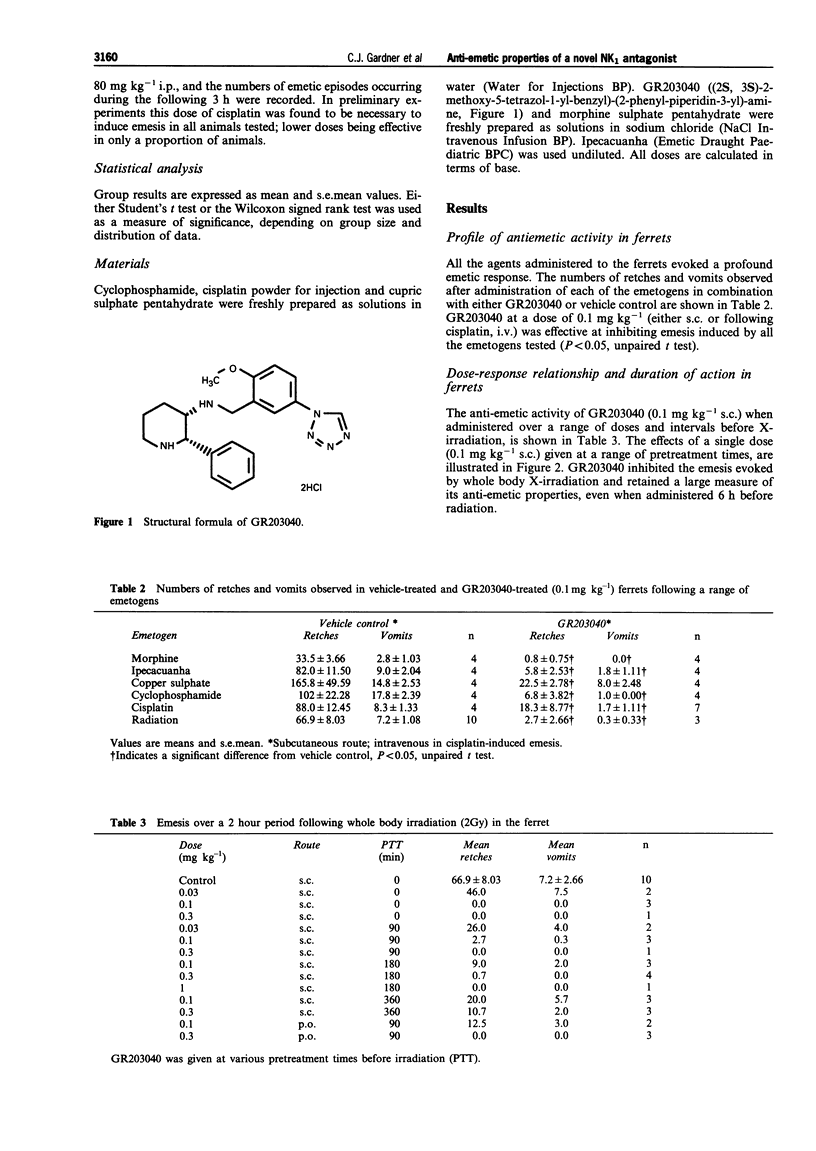
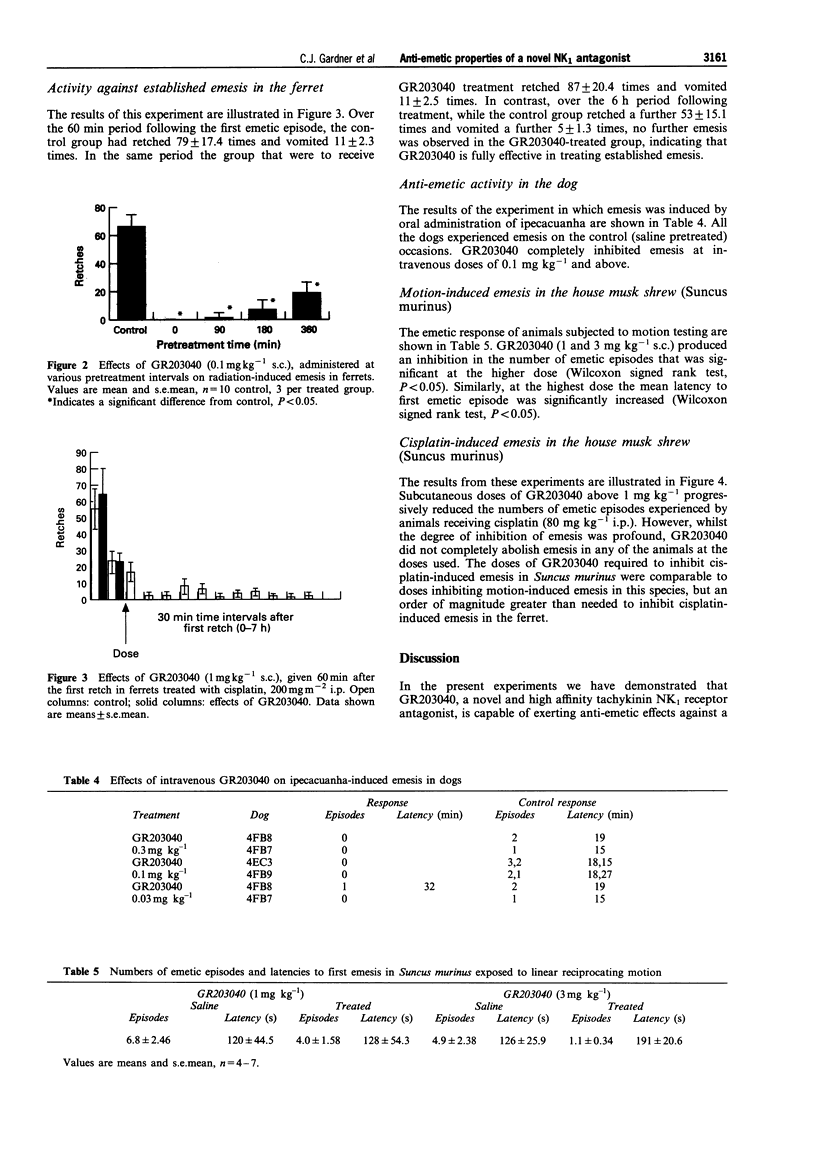
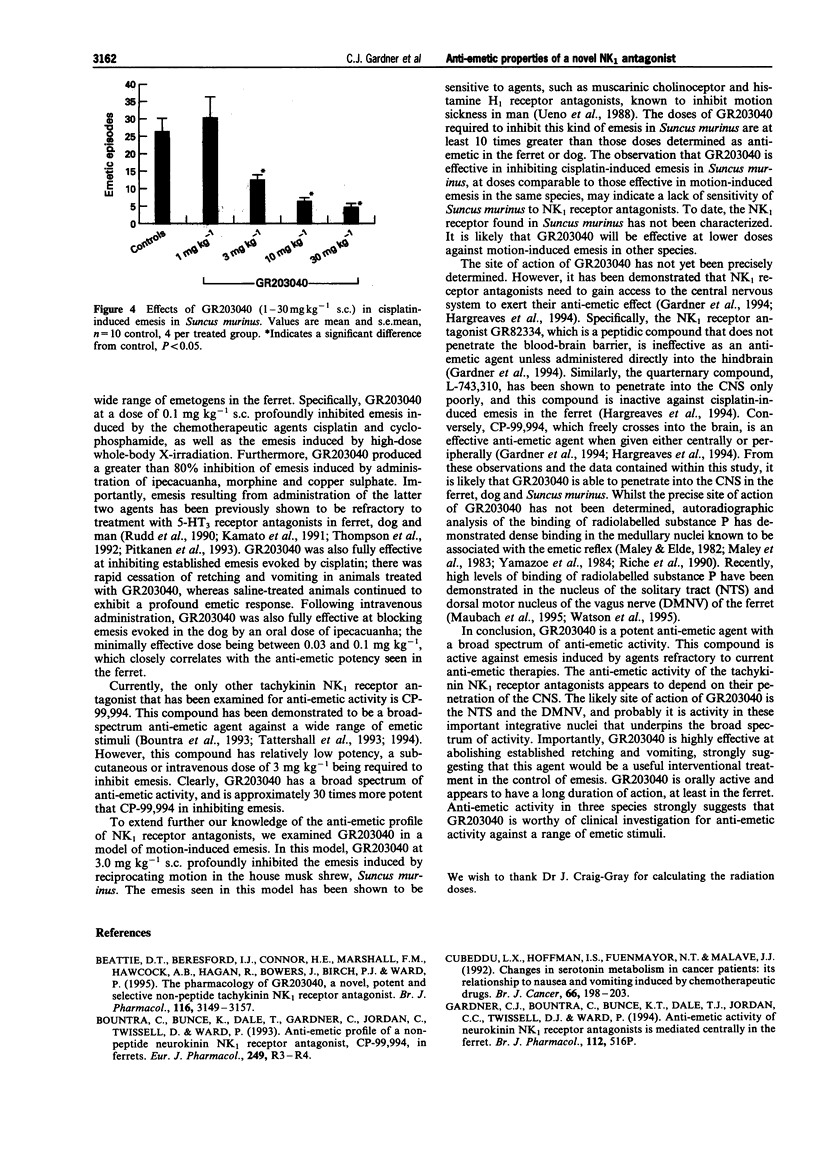
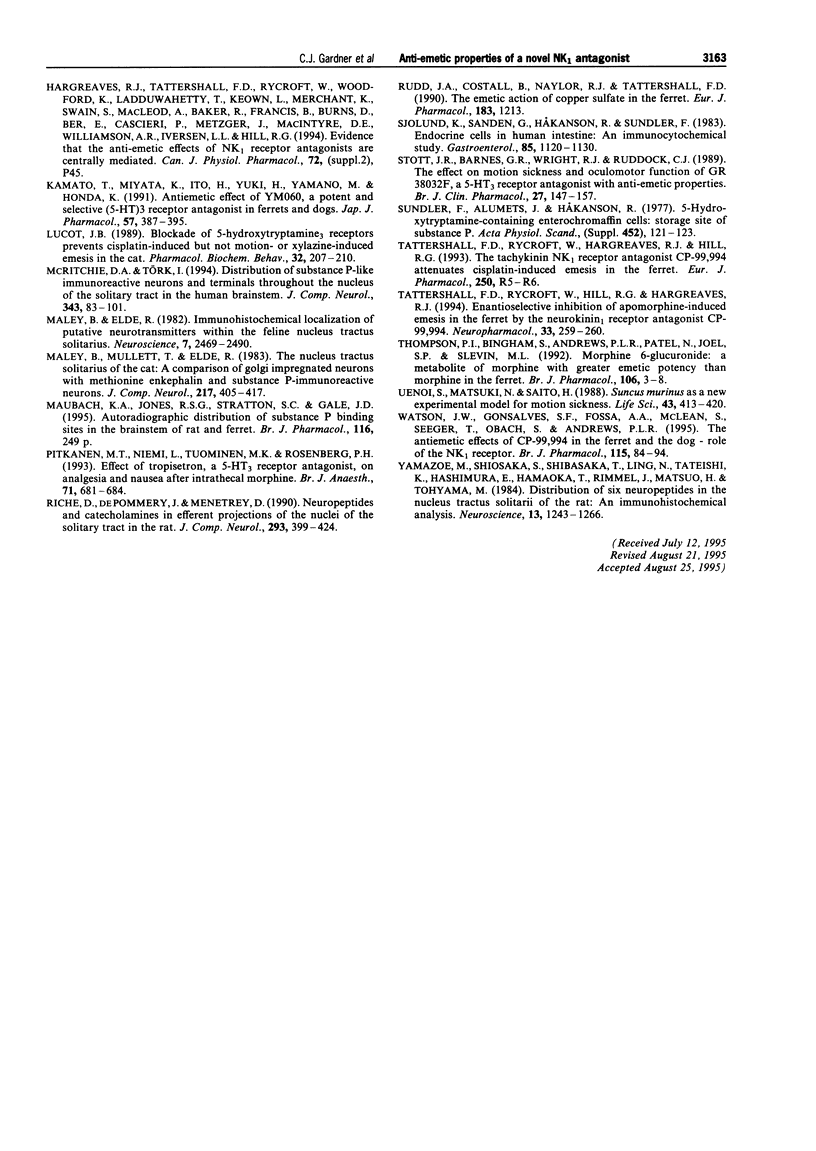
Images in this article
Selected References
These references are in PubMed. This may not be the complete list of references from this article.
- Beattie D. T., Beresford I. J., Connor H. E., Marshall F. H., Hawcock A. B., Hagan R. M., Bowers J., Birch P. J., Ward P. The pharmacology of GR203040, a novel, potent and selective non-peptide tachykinin NK1 receptor antagonist. Br J Pharmacol. 1995 Dec;116(8):3149–3157. doi: 10.1111/j.1476-5381.1995.tb15117.x. [DOI] [PMC free article] [PubMed] [Google Scholar]
- Cubeddu L. X., Hoffmann I. S., Fuenmayor N. T., Malave J. J. Changes in serotonin metabolism in cancer patients: its relationship to nausea and vomiting induced by chemotherapeutic drugs. Br J Cancer. 1992 Jul;66(1):198–203. doi: 10.1038/bjc.1992.242. [DOI] [PMC free article] [PubMed] [Google Scholar]
- Kamato T., Miyata K., Ito H., Yuki H., Yamano M., Honda K. Antiemetic effects of YM060, a potent and selective serotonin (5HT)3-receptor antagonist, in ferrets and dogs. Jpn J Pharmacol. 1991 Nov;57(3):387–395. doi: 10.1254/jjp.57.387. [DOI] [PubMed] [Google Scholar]
- Lucot J. B. Blockade of 5-hydroxytryptamine3 receptors prevents cisplatin-induced but not motion- or xylazine-induced emesis in the cat. Pharmacol Biochem Behav. 1989 Jan;32(1):207–210. doi: 10.1016/0091-3057(89)90235-9. [DOI] [PubMed] [Google Scholar]
- Maley B., Elde R. Immunohistochemical localization of putative neurotransmitters within the feline nucleus tractus solitarii. Neuroscience. 1982 Oct;7(10):2469–2490. doi: 10.1016/0306-4522(82)90208-1. [DOI] [PubMed] [Google Scholar]
- Maley B., Mullett T., Elde R. The nucleus tractus solitarii of the cat: a comparison of Golgi impregnated neurons with methionine-enkephalin- and substance P-immunoreactive neurons. J Comp Neurol. 1983 Jul 10;217(4):405–417. doi: 10.1002/cne.902170405. [DOI] [PubMed] [Google Scholar]
- McRitchie D. A., Törk I. Distribution of substance P-like immunoreactive neurons and terminals throughout the nucleus of the solitary tract in the human brainstem. J Comp Neurol. 1994 May 1;343(1):83–101. doi: 10.1002/cne.903430107. [DOI] [PubMed] [Google Scholar]
- Pitkänen M. T., Niemi L., Tuominen M. K., Rosenberg P. H. Effect of tropisetron, a 5-HT3 receptor antagonist, on analgesia and nausea after intrathecal morphine. Br J Anaesth. 1993 Nov;71(5):681–684. doi: 10.1093/bja/71.5.681. [DOI] [PubMed] [Google Scholar]
- Riche D., De Pommery J., Menetrey D. Neuropeptides and catecholamines in efferent projections of the nuclei of the solitary tract in the rat. J Comp Neurol. 1990 Mar 15;293(3):399–424. doi: 10.1002/cne.902930306. [DOI] [PubMed] [Google Scholar]
- Sjölund K., Sandén G., Håkanson R., Sundler F. Endocrine cells in human intestine: an immunocytochemical study. Gastroenterology. 1983 Nov;85(5):1120–1130. [PubMed] [Google Scholar]
- Stott J. R., Barnes G. R., Wright R. J., Ruddock C. J. The effect on motion sickness and oculomotor function of GR 38032F, a 5-HT3-receptor antagonist with anti-emetic properties. Br J Clin Pharmacol. 1989 Feb;27(2):147–157. doi: 10.1111/j.1365-2125.1989.tb05345.x. [DOI] [PMC free article] [PubMed] [Google Scholar]
- Sundler F., Alumets J., Håkanson R. 5-Hydroxytryptamine-containing enterochromaffin cells: storage site of substance P. Acta Physiol Scand Suppl. 1977;452:121–123. [PubMed] [Google Scholar]
- Tattersall F. D., Rycroft W., Hill R. G., Hargreaves R. J. Enantioselective inhibition of apomorphine-induced emesis in the ferret by the neurokinin1 receptor antagonist CP-99,994. Neuropharmacology. 1994 Feb;33(2):259–260. doi: 10.1016/0028-3908(94)90018-3. [DOI] [PubMed] [Google Scholar]
- Thompson P. I., Bingham S., Andrews P. L., Patel N., Joel S. P., Slevin M. L. Morphine 6-glucuronide: a metabolite of morphine with greater emetic potency than morphine in the ferret. Br J Pharmacol. 1992 May;106(1):3–8. doi: 10.1111/j.1476-5381.1992.tb14284.x. [DOI] [PMC free article] [PubMed] [Google Scholar]
- Ueno S., Matsuki N., Saito H. Suncus murinus as a new experimental model for motion sickness. Life Sci. 1988;43(5):413–420. doi: 10.1016/0024-3205(88)90520-6. [DOI] [PubMed] [Google Scholar]
- Watson J. W., Gonsalves S. F., Fossa A. A., McLean S., Seeger T., Obach S., Andrews P. L. The anti-emetic effects of CP-99,994 in the ferret and the dog: role of the NK1 receptor. Br J Pharmacol. 1995 May;115(1):84–94. doi: 10.1111/j.1476-5381.1995.tb16324.x. [DOI] [PMC free article] [PubMed] [Google Scholar]
- Yamazoe M., Shiosaka S., Shibasaki T., Ling N., Tateishi K., Hashimura E., Hamaoka T., Kimmel J. R., Matsuo H., Tohyama M. Distribution of six neuropeptides in the nucleus tractus solitarii of the rat: an immunohistochemical analysis. Neuroscience. 1984 Dec;13(4):1243–1266. doi: 10.1016/0306-4522(84)90296-3. [DOI] [PubMed] [Google Scholar]




